Mikhail Matovnikov,
chief expert of Center for Economic Analysis
of Interfax information agency
Russian Banking: High Potential, Even Higher Risks
This report was prepared for Russian Banking Forum, 7-8 December 2000, London
1. Russian banks vs. Eastern European banks: bound to be first
Russian banking system still did not recover its size characteristics in dollar terms. At present Russia has the 2nd place in Central and Eastern Europe by aggregate assets. Two years ago Russian banking system was the biggest among the post-socialist economies and had assets exceeding $100 bln. Poland had the 2nd place with assets of $68.5 bln. and Czeck Republic was the third with assets $55.5 bln.
Size characteristics of banking systems of Central and Eastern Europe as of July 1, 2000
|
Country |
Assets |
Foreign assets |
Foreign liabilities |
|
$ bln. |
rank |
$ bln. |
rank |
$ bln. |
rank |
|
Poland |
80,6 |
1 |
8,9 |
3 |
6,7 |
2 |
|
Russia |
67,2 |
2 |
15,6 |
1 |
7,9 |
1 |
|
Czech Rep. |
50,7 |
3 |
11,9 |
2 |
5,7 |
3 |
|
Slovak Rep. |
15,6 |
4 |
1,6 |
8 |
0,6 |
8 |
|
Hungary |
13,9 |
5 |
3,2 |
4 |
3,0 |
4 |
|
Slovenia |
12,8 |
6 |
1,9 |
6 |
1,4 |
6 |
|
Romania |
6,4 |
7 |
0,0 |
13 |
0,5 |
10 |
|
Ukraine |
5,0 |
8 |
1,0 |
9 |
0,4 |
12 |
|
Bulgaria |
4,9 |
9 |
1,8 |
7 |
0,5 |
11 |
|
Latvia |
3,7 |
10 |
2,0 |
5 |
1,9 |
5 |
|
Estonia |
2,9 |
11 |
0,7 |
10 |
0,9 |
7 |
|
Kazakhstan |
2,5 |
12 |
0,5 |
12 |
0,2 |
13 |
|
Lithuania |
2,3 |
13 |
0,6 |
11 |
0,5 |
9 |
Source: International Financial Statistics.
Assets of the Russian banking system, $bn.

International comparisons show very important fact: Russian banks still are the biggest international players in Eastern Europe as they always were. Their foreign assets are much higher then ones of any other country of the region, and their borrowings are also higher.
This reflects higher export potential of the Russian economy and hidden capital flight as well. At the same time it allows to speak about high potential of Russian banks. They have enough resources that may be directed to lending but still are placed on accounts in foreign banks
Rate of Russian banking system assets growth after the crisis was very high. Since end 1998 assets of Russian banks (on the latter dates failed banks were omitted from the sample) grew by $30 bln. (66%), of which in the first 9 months of 2000 they grew by $17.6 bln. In early 2001 Russian banks will return itself 1st place in regional ranking by assets. More distant perspective of achieving $100 bln. assets depends on balance of payments condition. But this level seems to be determined by basic characteristics of the Russian economy and will be attained sooner of later.
It may be said almost for sure that in the next 2 years assets of the Russian banks will grow by at least $20 billion.
In dollar terms Russian GDP even after devaluation is one third higher GDP of Poland and 3 times higher one of Czech Republic Size effect guarantees Russia high place in regional ranking, but Russia also has a natural advantage. She is one of a few Eastern European countries with positive balance of the current account. With such external feeding Russian banks have guaranteed increase of resources and do not depend on decisions of foreign investors, although are very vulnerable to capital flight.
It is external non-credit sources that helped relatively fast banking system recovery after the 1998 crisis. In contrast many of Eastern European banks became foreign-owned as a result of banking crises that erupted in every post-socialist economy. Sometimes it was a deliberate government policy to hand over state-owned banks to foreign strategic investors. Often it was the only way to escape massive losses.
Places of Russian banks in World Top 1000 ranking by capital
|
Banks |
1997 |
1998 |
1999 |
|
Sberbank |
134 |
421 |
388 |
|
Foreign trade bank |
279 |
689 |
454 |
|
Gasprombank |
- |
687 |
647 |
|
Sobinbank |
- |
807 |
728 |
|
Unexim bank |
346 |
782 |
- |
|
SBS-Agro |
536 |
- |
- |
|
MFK |
670 |
- |
- |
|
Rossijsky credit |
683 |
- |
- |
|
Menatep |
697 |
- |
- |
|
Tokobank |
720 |
- |
- |
|
Incombank |
761 |
- |
- |
|
Imperial |
852 |
- |
- |
|
Mosbusinessbank |
919 |
- |
- |
|
Promstroybank Russia |
993 |
- |
- |
|
Number of banks |
14 |
5 |
4 |
Source: "The Banker"
Average Russian bank is much smaller then its Eastern European collegues. In 2000 average assets of a Russian bank were just a bit higher then $50 mln. This is 3 times smaller then in Romania or Bulgaria. This picture is a result of a large number of tiny banks operating in Russia. According to the data of Statistical Survey "INTERFAX-BANKS: Russian Banks" in Russia still operate banks with assets just 150 000 rubles ($5500). This would be impossible according to legislation of most Eastern European countries. In Russia Central bank has abolished after devaluation its own decision to force banks with capital below $1 mln to re-register as non-bank credit organizations.
But if you look at the biggest Russian banks everything looks different. Russian banks (Sberbank and Foreign Trade Bank) in 1997 headed the group of the biggest Eastern European banks. In 1998 the biggest Russian bank - Sberbank - was down to 6th place, with 3 Polish and 2 Czech banks ahead. Foreign Trade bank occurred even beyond the group of 10 leaders. In 1999 leading Russian banks moved forward but still did not reached firm leading places. It seems in 2000 two Russian banks (Sberbank and Foreign Trade Bank) will again pretend on the first two places in the regional ranking.
2. Banking Crisis Is Over… As Well As Banks' Power
RECOVERY INSTEAD OF DISASTER
Biannual "Interfax-100: Top Russian banks" Report issued in early October had bold sub-title "Banking Crisis Is Over". One month later this became a very popular newspaper heading in Russia after it was repeated by high Central Bank official. That suggests we lead banking research in Russia and often produce new ways of looking on the Russian banking system. What moved us to say that the crisis is over?
When in 1998 banking crises erupted most analysts agreed that we may expect loan contraction, painful recovery of banks and that this problem will burden the budget for years. The Central Bank of Russia had estimated it would cost 100 billion rubles (4.5% of GDP) to pull banks from crisis and analysts agreed that a long period of restoration and recapitalization, a drop in lending and a further degradation of the banking system lay ahead. But reality surpassed even the most optimistic forecasts. In fact 2 years later we have rising banks' loan portfolio and capital, banks returned to profitability and apart from 2 state banks government did almost nothing to help the banking system.
It is perhaps a little realized fact, but the rapid reincarnation of banks following the 1998 crisis was in no way a result of virtues of the banking system. Banks made little effort to get through the crisis and most progress that was made was the result of purely economic factors. The rapid recovery made by banks after the crisis was the result of powerful, short-term processes related to monetary stabilization.
In 1999 ALL banks with not ultimately damaged franchise were able to recover. In was not a result of new management teams or lessons drown from the previous experience as many Russian bankers claim, but help came from the external factors that lay beyond bankers (and even Russian government) control. These factors are unlikely to last for a long time or be repeated again.
EMISSION STOPPED LIQUIDITY CRISIS
The money base began growing in constant prices in the second quarter of 1999 thanks to greater certainty over the rate of devaluation of the ruble and the rate of inflation. Not by chance did the capital of the banking system stop falling in March 1999. Renewed demand for money meant an end to the liquidity crisis for banks and the opportunity to normally meet their liabilities.
The factors that led to further improvement in the banking system changed in 2000. Russia’s substantial trade surplus created the need for massive ruble emission by the Central Bank to prevent an increase in the real exchange rate of the ruble. The Central Bank’s monetary policy was formally very tough. The Central Bank offered virtually no refinancing for banks and no financing for the government, but in combination with its policy to support the ruble, monetary policy was very soft. The Central Bank in the first half of the year refrained from raising the reserve requirements, leaving them at their levels on January 1, 2000, and relied more heavily on market instruments to sterilize emission.
Reserve money increased 67% in 1999 and despite a tougher monetary and financial policy, by another 45% in the first half of 2000. As a result of this substantial emission, the banking liquidity crisis has ended in the first half of 1999. Banks that were able to hold on to their business, even if they had lost a large portion of their capital, were able to pay creditors. The acute stage of the crisis ended by the second quarter of 1999, and the recovery process moved into a phase that involved working with bankrupt banks and solving the problem of past due debt.
BANKS SOLVED PAST DUE LOANS PROBLEM BY MID-2000
Russian banks spent more than 51.6 billion rubles to write off bad loans in 1998 - first half 2000, including 16 billion rubles in 1998, 27.2 billion rubles in 1999, and 8.5 billion rubles in the first half of 2000. These figures show the balance of paid and restored (a decrease in reserves in the event of an improvement in loan quality) reserves for possible loan losses. Gross loan reserves created in the two and a half year period from 1998 to mid-2000 were 342.1 billion rubles, but 290.5 billion rubles of this was restored. However, this figure includes a significant amount of double counting. Alfa Bank alone accounted for 124 billion rubles of reserves formed, but 118 billion rubles of this was restored judging by gross figures.
It is no surprise that banks with 100% foreign capital (further - foreign banks) formed most of their reserves in the first few months after the financial crisis, which resulted in a negative capital for most of them. Foreign banks paid 78.2% of total bad loan reserves in 1998 and the first quarter of 1999. For comparison, most Russian banks formed 48.8% of reserves in this period, including 46.9% for Moscow banks and 59.5% for regional banks. This figure was slightly lower, at 44.9%, for the 10 biggest banks as of July 1, 2000 (according to the Interfax-100), not least due to Foreign trade bank, which accounted for nearly 60% of reserves formed by these banks in 1998 and nearly a third of those formed in the first quarter of 1999.
History has shown once again that shareholders interested in real information about bank is a vital factor in achieving an adequate representation of the financial standing of a bank. By quickly forming reserves for bad loans, foreign banks could just as quickly restore profitability and begin to increase their capital. Foreign trade bank and foreign banks were able to receive financing from shareholders after the situation became clear to increase capital and write off bad debt.
The second wave of write-offs came in the final quarter of 1999, when banks paid nearly 11 billion rubles to reserves. Foreign trade bank set the tone again, accounting for nearly 50% of this. Alfa Bank had made massive write-offs in the third quarter of 1999. This surge in reserves shows the impact of a tougher approach by the Central Bank of Russia to the timely formation of reserves. As a result, capital began to grow more slowly, but the share of bad loans dropped from 8.2% to 6.2%.
The biggest write-offs this year were made at two banks – SBS-Agro and Rossijskiy Kredit, which are being restructured by ARCO, which led to a further drop in their capital. In 3rd quarter biggest reserves again were created after recapitalization by Foreign trade bank.
The formation of reserves was completed in the first half of 2000. Many banks that had actively paid reserves in late 1999 and early 2000 are doing the reverse. Alfa Bank and Foreign trade bank in the second quarter of this year paid fewer reserves than they restored.
The consequences of the 1998 financial crisis have been overcome. The problem of bad debt left after the 1998 crisis will no longer have a deciding influence on the profitability of Russian banks.
MARKET NICHE OF INSOLVENT BANKS FILLED
Another important consequence of the crisis - the disappearance of the giant banks, had a negative impact on the market for a relatively short period. The methods of saving bank empires, which were not always fair to creditors, had a positive result for the economy: new banks with a fairly extensive infrastructure quickly occupied the market niche once held by these banks.
Because banks played an insignificant role in the economy the problem of drawn out efforts to restore loans was eliminated. Bank claims on the private sector were just 9.2% of GDP in mid-1998, compared with 34.9% in Mexico on the eve of the 1994 devaluation and 58.2% in South Korea just ahead of the mid-1997 financial crisis there. Since commercial loans were only a very small part of GDP in Russia and were made largely to borrowers that were in some way related to banks, whose assets and liabilities were moved to bridge banks, the problem of settling bad debt was much less acute.
GOVERNMENT PROVIDED LITTLE SUPPORT FOR BANKING SYSTEM
The government and Central Bank have had only an indirect impact on restoring the banking system, as objective economic processes have done much of the work for them. Active government policy towards banking sector was limited to just two banks: Sberbank and Foreign Trade Bank. In 1998 Central Bank purchased from Sberbank part of defaulted government bonds portfolio, which was the main source of bank's record profits for 1998. Capital injections in Foreign Trade Bank by Central Bank amounted to 40 bln rubles. Private banks received little support with 2 noticable exceptions: Avtobank and Alfa-bank. These two banks received loans from Central bank (2.5 bln. rub) and ARCO (1 bln. rub) respectively.
ARCO, the Agency for the Restructuring of Credit Organizations, was supposed to have a recuperative influence on the banking system. The agency has in fact achieved more promising results than has the Central Bank. The agency has shown the best results in the recovery of seven small regional banks – AvtoVAZbank, Vyatka-Bank, Eurasia Bank, Investbank, Kuzbassugolbank, Pyotr Pervy, and Chelyabkomzembank and one Moscow bank – RNKB – which fully paid their debt to the budget and other creditors and have returned to profitable operation since the start of 2000. Its successes in restructuring SBS-Agro and Rossijsky credit were much more modest.
RUSSIAN BANKS LOSING TOP POSITIONS IN ECONOMY
Russia’s stronger economy has revealed an important fact – the banking system’s claims on a leading role in the economy are untenable. After the financial crisis of 1998 the banking sector will never regain its leading position.
The net profit of Russian enterprises in the first eight months of the year was 673.6 billion rubles, which was 15% more than the loans banks made to enterprises, according to the State Statistics Committee. Russian businesses largely get by without financing from the country’s banks.
Industry has firmly claimed center stage in the economy and the banking system is being relegated to its proper place as a provider of financial services instead of an economic flagman. Banks need only occupy their niche in the economy, which opens up new opportunities to develop traditional banking operations but places much higher demands on bank management.
3. Russian Banking System Recovery: Myths And Reality
HAS CREDIT QUALITY IMPROVED?
For the first time in recent years conditions are right in the Russian banking system for a substantial increase in lending. In 1994 – 1998, for each ruble of increase in lending to Russian residents, bank liabilities increased by just 65 kopecks. In other words, the liquid assets of Russian banks dropped by 35 kopecks. This money was either turned into cash or left the financial system altogether. An increase in lending under these conditions resulted in a sharp increase in the liquidity risk.
The reverse was true from the fourth quarter of 1998 throughout 2000. Lending increased amid a substantial increase in liabilities, which in some quarters even topped the increase in lending. In the fourth quarter of 1998 this was caused by devaluation in the ruble and an increase in hard currency obligations over hard currency loans. The factor of an increase in the exchange rate was far less in 1999, but the tendency was the same. Russia has never before seen such an extensive period of credit expansion that did not hurt liquidity. This has happened just once since 1994, (when this information became available) amid similar circumstances in monetary stabilization – in the second quarter of 1995, but the situation quickly changed for the worse.
One of the most cited signs of banking recovery is reduction of the share of bad debts in loan portfolio. Share of past due loans fell from 13.1% to 4.4%, or by 66% in 2 years after the crisis. As already said some of this reduction was due to bad debt write-offs, but this is not the end of the story.
The rapid increase in lending masks the true state of the loan portfolio. The amount of current loans increased by 214% in this period, and 64% of this increase was for loans for more than six months. A change in portfolio structure by providing new loans can lower the share of past due by 24%. The actual share of past due loans among loans to enterprises in all industries in rubles dropped by 51%. So the real improvement in loan quality was not so significant.
The rate of lending expansion raises the question of the degree of balance. As lending increases it is difficult to tell whether the increase in sales by enterprises was the result of an increase in business or the receipt of loans by related enterprises. In the latter instance, there is a great danger of the rapid deterioration in a credit quality if the rate of lending slows down and problems servicing loans arise.
But past due on loans in rubles has already begun to grow in some branches, namely industry and construction, where it was up 6.5% and 15%, respectively. Despite a general drop in the share of past due loans, the increase in these two sectors is alarming.
The actual quality of newly extended loans becomes evident only as they come due in 2000, and given the practice of repeat lending, even later – in 2001 or 2002. Now we can't be sure that new loan expansion is sound.
Changes in loan portfolio of Russian banks to enterprises in 1998 – 2000
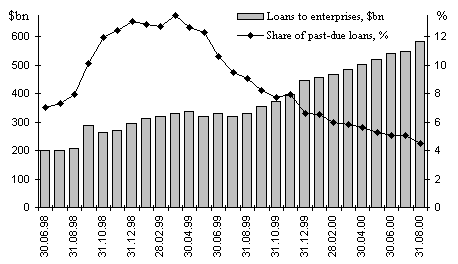
Source: Central Bank of Russia
LOAN AND DEPOSIT PYRAMID
Another factor that helped to lower the share of past due was an increase in the monetization of the economy, which was effected through an increase in lending. Lending is growing faster than interest income is received on loans, so a large portion of enterprises can refinance their debt with new loans. The increase in lending facilitates a drop in the share of past due, which drops as a result of increased lending. In any event, it is too soon to say that credit expansion has had a balancing effect as a slower increase in loan portfolios could well lead to an increase in the share of problem loans.
Cost of servicing loans to enterprises in rubles, % annually
|

|
1 - net growth rate of loan portfolio (difference of loans extended in a month and interest received), left axis
2 - real interest rate on 3-month loans in rubles, right axis
|
Source: Interfax CEA
A rare deposit pyramid situation is taking shape in bank liabilities. Deposit operations are bringing a sort of “income.” The accumulation of deposits in Sberbank, and at other commercial banks in most of 1999 and 2000, exceeded interest payments even on the highest rates for the whole period. The simple presence of a banking license and trust by clients essentially brought banks "income" even on liability operations, while in a normal situation banks would have to wisely place resources to make payments to creditors.
Cost of servicing deposits in rubles, % annually
|
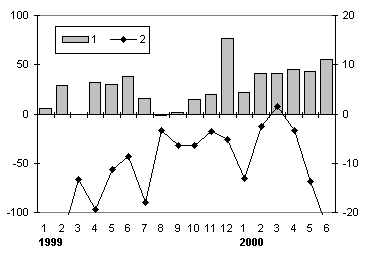
|
1 - net growth rates of deposits (difference of attracted deposits and interest payments), left axis
2 - real interest rate on 3-month deposits in rubles, right axis
|
Source: Interfax CEA
There is no need to say that the development of banks in 1999 and 2000 was an exception that strayed far from the canons of banking activity, and such a combination of circumstances can’t go on forever. Banks are basically surviving on an external feeding system similar to a financial pyramid. The process of servicing their liabilities is eased by the accumulation of new money and if the resources attracted in this manner are not invested in profitable projects, the end to expansion can put an end to the process of restoration in the banking system. A new crisis could erupt when the real quality of lending is revealed, and the constant refinancing of obligations with new resources will be replaced by the need to pay on these obligations out of bank earnings.
Financial stabilization has created a sort of virtuous circle: A rapid increase in liabilities provides a rapid increase in the loan portfolio, which substantially improves loan quality indicators. This combination of factors creates the illusion of a balanced growth and restoration of the banking system, but at the same time negative tendencies are showing through.
POCKET BANKING VS. COMMERCIAL BANKING
The rapid growth of banks that served exporters was the most prominent phenomenon in late 1999 and early 2000 and was due entirely to favorable trends on world markets. Russia’s current accounts surplus in the first half of 2000 was nearly $23 billion (for comparison the assets of the entire Russian banking system on January 1, 2000 were estimated at $58.6 billion). This windfall enabled banks to pay on foreign loans and increase their assets at the same time.
The assets increased in a manner that was quite unfavorable for the economy – assets increased as a result of new money placed on client accounts rather than as a result of increased lending by banks. Less than 40% of the assets increase in the first half of the year was the result of new loans, as the increase in net foreign assets and reserves in the Central Bank of Russia were more significant factors. Reserve money increased entirely under the influence of an increase in the Central Bank forex reserves and the Central Bank even reduced lending to the economy. As a result, the increase in assets was about 60% due to foreign economic trends up until mid-year.
Sources of increased liabilities in banking system in 2000, bln rubles
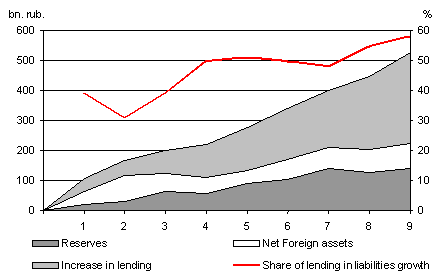
Source: Interfax CEA
Naturally foreign trade factors affect only a small number of banks. Banks that have major exporters as their clients were either catapulted into the group of biggest banks or strengthened their positions among them. The recipe for rapid growth in 2000 was fairly simple – make sure you have major exporters as clients and shareholders.
A comparison of the operations of the new leaders and the banks that led the pack prior to the 1998 crisis shows a surprising difference. The leaders of 1998 were active lenders and were the biggest creditors of the economy, and what is particularly important, they made very long-term by Russian standards loans. Many of the new leaders (some of which were among the biggest banks two years ago) are engaged in a very limited range of operations. These banks place a large portion of money on correspondent accounts in foreign banks and the Central Bank of Russia, and focus on corporate settlement accounts, rather than term resources drawn from various sources. Some of the big banks of today not only are not expanding financing to the non-banking sector, but also are even decreasing it. Two years ago a bank with this balance sheet structure would have been immediately classified as a small “pocket” bank that merely performed clearing functions for its parent company and had undeveloped asset operations and low capitalization. By the middle of 2000 many bank leaders were “giant pocket” banks, judging by their balance sheet structure.
Thus, the economic situation put pocket banks in the lead or made pocket banks of those that were once large universal banks. The owners of banks that turned into virtual treasury departments of large corporations could be completely indifferent toward developing a loan business and normal bank business. These shareholders had no need for financing and no need to use banks to accumulate resources of other enterprises. The prospect of additional income from a loan business was unappealing because it first required a sharp increase in bank capital. Lending, in addition to the risks it entails, ties up liquid resources that could be needed in the event of a change in the world market situation.
Balance sheet structure of 100 biggest banks before and after 1998 crisis at mid-year, as % of assets
|
Structure of assets, % |
Structure of liabilities, % |
|
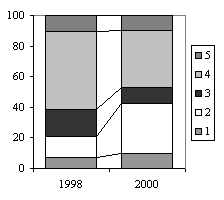
|
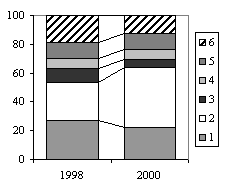
|
- Cash and accounts in Central bank
- Deposits in banks
- Securities
- Loans
- Other assets
|
- Deposits of banks
- Deposits of enterprises
- Individualls' deposits
- Debt instruments
- Other liabilities
- Capital
|
Source: Interfax CEA
In theory, which was confirmed by Russian practice in 1997 and 1998, big banks have a greater opportunity to save on scale to increase the effectiveness of their operations as financial consultants. Bigger banks can afford to have a larger share of loans in assets, longer terms of lending and are less in need of liquid funds. Unlike their foreign colleagues, Russian banks are still fairly small, which makes economy of scope very noticeable, the presence of this often comes under question at the world’s big banks.
Many of the new leaders have a limited loan business or the scale of their asset operations is far smaller than it could potentially be. Surgutneftegazbank is a good example of this. The bank’s record low capitalization (0.5% of assets) would be a cause for concern if it weren’t for the structure of asset placement: most of the bank’s assets are in correspondent accounts in foreign banks and the Central Bank of Russia. A lead built entirely on liabilities is obviously not very solid and settlement operations are too basic a service to be a long-term competitive advantage.
The situation began to change in the second half of the year as foreign factors lost their influence and the share of the increase in the loan portfolio in increase liabilities to residents began to increase quickly. Over the next six months it will probably return to a more traditional level for Russian banks of 80% - 90%, as in 1994 – 1998.
In other words, the accumulation of resources in the banking system has begun to move toward a qualitative rather than quantitative plane. With this new stage, the participation of the banking system in financing economic growth has finally become possible. A return to normal in the banking system will inevitably have an impact on the competitive advantages of certain groups of banks, but these changes have yet to change much among the group of leaders.
4. Banking Services: Low Start And High Potential
It appears that reality has not lived up to the expectations of the authors of the government mid-term program for banks (the program was developed by the Center for Strategic Research headed by German Gref). There are no signs of rapid development in the banking system. Moreover, the share of banking system assets in GDP has begun to drop. And not only are assets dropping, but reserves and capital are falling as well.
These changes broke the upward trend in the key banking indicators in real terms that followed the stabilization of the ruble in 1995 and was not disturbed by even devaluation. On the contrary, the high share of assets in hard currency led to an accelerated growth in banking assets relative to GDP when the ruble devalued, and the slight drop in capital after devaluation more likely shows the poor quality of reporting by banks than actual well being.
The drop in capital to GDP accelerated in 2000, which was a comparatively good year. The drop was caused by an increase in GDP in real terms, not a drop in indicators, but the fact that banks lag behind processes in the real sector is becoming all the more obvious. Banks have been unable to increase their share, despite even a decrease in non-payments and an increase in the sphere of money circulation.
Lending is limited by undercapitalization of banks, not low competition The amount of loans provided is determined by the financial constraints of banks – liquidity and capital, rather than by low competition in the banking sector. Bank capital only recently topped pre-crisis levels, but lending in the period increased by 130%. The amount of lending was already more than considered prudent in a pre-crisis period. Further expansion comes up against capital to assets restrictions, but liquid assets enable banks to double lending. At the same time, overstating interest rates is possible because of the restriction on loans provided.
Share of key banking indicators in Russian GDP at year-end
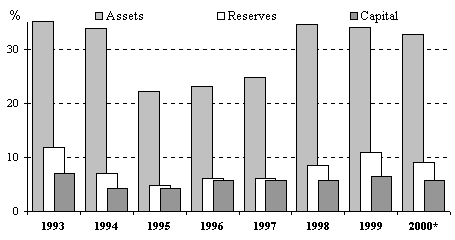
* Estimate at close of third quarter
Source: Interfax CEA
Thus, resources of Russian banks are already sufficient to double lending, continued capital inflows add to this ability every month. Better prospects for the real sector and rising personal incomes both promise high rewards for banks. At this stage of optimistic expectations banks have started struggle for future leadership.
Potential amount of loans Russian banks could provide, bln rubles
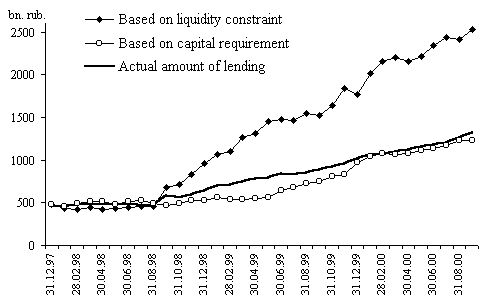
Source: Interfax CEA
5. Struggle For The 2nd Place
Sberbank’s position as the biggest retail bank can’t be shaken even by the introduction of guaranteed deposits in commercial banks, but a serious battle for corporate clients has unfolded. Improved foreign trade conditions for oil producers and metallurgical companies enabled shareholders to create new banks or resurrect old ones. The increase in industry has made enterprises more desirable clients, which were previously overlooked by Moscow banks.
TRANSIENT LEADERS
The success of certain banks that resulted from foreign economic trends stood out and distracted attention from the processes going on below the surface in the banking system. Economic growth is gradually decreasing the influence of raw materials exporters and is increasing the share held by processing enterprises and the banks that serve them.
Rate of assets increase for main groups of banks out of 100 biggest banks, first half of 2000
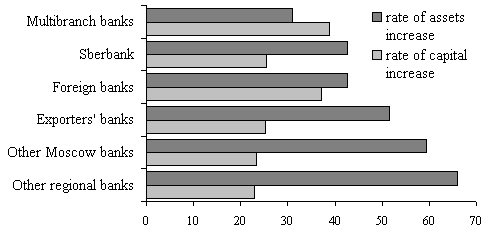
Source: Interfax CEA
The assets of banks that served exports soared by 51.5% in 9 months. But the beginnings of traditional banking business were overshadowed by the impressive rise of banks that served exporters. The regional banks were the first to detect this new trend. The assets of regional banks that were not involved with export companies rose much faster, gaining 66% in the first nine months of the year, outstripping even Sberbank, whose assets grew 42.6% in the period.
On the other hand, foreign banks and banks with extensive branch networks grew more slowly (if problem banks are not included), with assets up 42.6% and 31.0%, respectively, in the 9 months of the year.
A redistribution of power is occurring in the banking system and more often than not the scales are not tipping in favor of banks that serve exporters. These banks increased capital no faster then other groups (25%). With Gasprombank excluded capital increase will be only 10%. Banks with extensive branch networks that were not among the “export banks” increased capital by nearly 40%.
The current rapid growth in earnings of Russian exporters is a temporary phenomenon that is caused by a rise in prices on commodities markets, not by an increase in production volume. Production is increasing in the processing industries. Economic growth will facilitate an increase in the market share of universal banks regardless of world trends.
Even the restoration of the economy cannot cause the banking system to grow faster than GDP, only by working with enterprises. The retail market remains key for banks, as it is the most important source of resources.
For objective reasons related to the structure of the Russian economy, the share of assets of banks that serve raw materials and metals exporters is about 20% - 25% of total banking assets. The unusually high figure for 2000 was the result of a combination of a balance of payments surplus and the effects of devaluation, but the share held by “raw materials’ banks will inevitably drop.
Banks with extensive branch networks can expect to double their market share and continue to grow. Competition with Sberbank will be even tougher than in 1996 – 1998, since Russia’s biggest bank has defined as its market a segment for working with a large number of enterprises.
At present big assets do not bespeak a bank’s potential, instead the nature of a bank’s business, the quality of management, and the ability to offer the best range of services are taking on greater significance. Up to a point the creation of a working infrastructure is not manifest in an increase in assets but growth potential is accumulated rapidly. By the same token, banks that have become preoccupied with drawing new resources could easily lose this money, since they may be unable to offer clients the services they want.
Change in share of various groups of banks in assets of 100 biggest banks, %
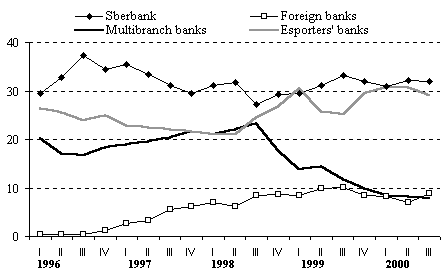
Source: Interfax-100
There are no commercial banks capable of providing a high level of service to a broad number of enterprises regardless of ownership relations between the bank and the enterprise, and this shortage is most acute in the regions.
The 1998 financial crisis dealt a devastating blow to the biggest banks with large branch networks – Inkombank, SBS-Agro, and Rossiyskiy Kredit. The quality of management at the banks was questionable, and in the end it led to bankruptcy and problems long before the 1998 crisis, but the fact remains – these banks found a niche for working with the population and regional enterprises not affiliated with financial and industrial groups and provided fairly stiff competition for Sberbank, often offering far better terms.
Inkombank, SBS-Agro and Rossiyskiy Kredit undoubtedly were the best known banking trademarks that took years to create. But the full return of the two latter banks to the market following a restructuring through ARKO after a two-year absence and loss of creditors is not likely to be successful if indeed at all possible. Sberbank, which has shifted its focus to the real sector, has filled their niche but there is still room for commercial banks.
Sberbank’s lead is unlikely to be toppled in the foreseeable future, but second place remains free. The group of Russia’s biggest banks will face big changes because there are no fundamental reasons for the lead held by some banks. Only a bank with a strong regional presence, high capitalization and stable resource base that does not depend on decisions by individual clients can move into second place.
The formula for success is to build a banking business with a large branch network that operates on commercial principles, with a large share of retail banking and corporate finance for enterprises that do not have their own banks. This road is undoubtedly rougher than working for one or a few giants that are often shareholders of the bank, but it has one significant advantage: a bank that adopts this strategy will grow with the economy, while working with exporters, even the biggest ones, always hinges on two important restrictions. First enterprises generally do not allow money to accumulate on their accounts, so banks should not expect an increase in liabilities, and secondly, the export business itself relies on production capacity and world market demand for the product.
The main problem of Russian banks at present is very low franchise value. No bank except Sberbank as fundamental factors that will keep or even increase its market. But most banks are busy building such fundamental strengths, who will succeed is to be seen.
CANDIDATES FOR LEADERSHIP
Branch networks were the most valuable assets left by large banks that left the market as a result of the financial crisis. It is not surprising that many banks were ready to help rehabilitate bankrupt banks on condition they gain access to their branches. Banks that bought or received the branch networks of the defunct giants undoubtedly acquired a valuable asset and laid the foundation for future growth.
The main heirs of fallen empires have yet to make it into the top ten. Menatep St Petersburg, which received most of Menatep’s branches, is only 19th in terms of assets; Guta-Bank, which acquired Inkombank branches is 25th, Impex Bank, the successor to Rossiyskiy Kredit is 51st, and Pervoye OVK, which received a large number of SBS-Agro branches, is only 108th in terms of assets. Foreign Trade Bank, which recently acquired Most-Bank, already had a large number of branches, but these branches obviously do not yet play a key role in its business.
The second important factor is the bank’s ability to increase capital, which enables it to increase lending. The change in the capital of Russian banks in 1999 and 2000 was quite interesting. It can be likened to a race in which banks take the lead from one another.
Bank leaders in terms of branches
|
¹ |
Bank's name (place by assets on Oct. 1, 2000) |
Number of regions |
Number of branches |
|
Total |
At place of registration |
Other regions |
|
1 |
SBS-Agro (16) * |
68 |
72 |
0 |
72 |
|
2 |
Foreign Trade bank (2) |
30 |
34 |
2 |
32 |
|
3 |
Bank of Moscow (9) |
27 |
36 |
2 |
34 |
|
4 |
Vozrozhdenie (31) |
20 |
66 |
44 |
19 |
|
5 |
Alfa Bank (6) |
20 |
19 |
0 |
19 |
|
6 |
Avtobank (18) |
19 |
25 |
7 |
18 |
|
7 |
Guta-Bank (25) |
19 |
37 |
18 |
19 |
|
8 |
Promstroibank St Petersburg (17) |
16 |
46 |
31 |
15 |
|
9 |
Sobinbank (22) |
16 |
16 |
1 |
15 |
|
10 |
Rosbank (11) |
13 |
13 |
1 |
12 |
|
13 |
Most-bank (33) * |
11 |
11 |
0 |
10 |
|
11 |
Petrokommerts (29) |
10 |
13 |
0 |
13 |
|
12 |
MDM-bank (14) |
10 |
10 |
0 |
10 |
* - banks being restructured. Number in parenthesis indicates bank's rank by assets size as of October 1, 2000.
The capital of large banks grew relatively smoothly up until 2000, but in late 1999 Foreign Trade Bank and Mezhprombank increased their capital to nearly $1 billion. The fate of a new share issue by Mezhprombank was complicated – it was registered only in May 2000. Once it was registered the bank shot into second place in terms of capital. But an increase in capital by Foreign Trade Bank in September by 20 billion rubles moved it in front, putting it first in terms of capital, beating even Sberbank.
Increase in capital by biggest Russian banks in 1999 – 2000, $bn.
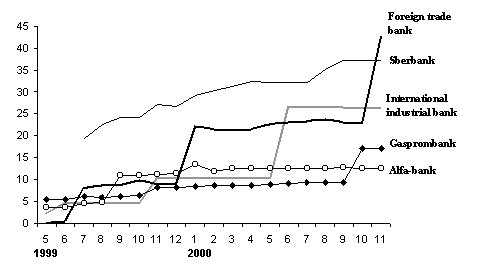
Source: Interfax CEA
The increase in Foreign Trade Bank in September, if it is used to acquire the shares of Soviet banks abroad from the Central Bank of Russia as was supposed, will not affect its capitalization according to international standards. The Basel banking conventions specify that investment in the shares of other financial institutions is not included in a bank’s capital. The new recapitalization was already used by Foreign Trade Bank to pay bad loan reserves.
Large capital makes it possible to considerably increase bank operations. Foreign Trade Bank in mid-2000 was able to increase the amount of high-risk assets it had by 190 billion rubles without violating capital to assets requirements and including the recapitalization in September this figure increases to nearly 400 billion rubles (which is more than Sberbank assets adjusted for risk in the middle of 2000).
Potential increase in assets at banks with largest capital
|
Bank |
Capital CBR, bln rubles. |
N1 |
Risk weighted assets, Bln rubles |
Possible increase in risk weighted assets, Bln rubles |
|
On Oct.1,2000 |
Maximum allowed |
|
Sberbank |
37,2 |
10,2 |
365,0 |
372,3 |
7,3 |
|
Internation industrial bank |
26,2 |
46,2 |
56,7 |
262,0 |
205,3 |
|
Foreign trade bank |
22,7 |
47,0 |
48,4 |
227,4 |
179,1 |
|
Gasprombank |
17,1 |
19,3 |
88,6 |
170,9 |
82,4 |
|
Alfa-bank |
12,5 |
25,2 |
49,5 |
124,7 |
75,2 |
|
Rosbank |
5,1 |
17,3 |
29,5 |
51,0 |
21,5 |
|
Globex |
5,0 |
33,2 |
15,1 |
50,2 |
35,1 |
|
Natioal Reserve bank |
4,8 |
49,7 |
9,6 |
47,7 |
38,1 |
|
MDM-bank |
4,5 |
23,2 |
19,4 |
44,9 |
25,6 |
|
Sobinbank |
3,8 |
24,2 |
15,6 |
37,8 |
22,2 |
|
Total |
|
|
|
|
|
Note: The maximum allowed is based on the assumption that the bank will reach the minimum capital to assets ratio of 10% N1 - capital adequacy ratio (Russian equivalent of Basle Capital Ratio), minimum is set on 10% for banks with capital above 5 million ECU.
Source: Interfax CEA.
It is not clear what sources bank owners expect to tap to increase capital so dramatically. It would be unwise for these banks to maintain a capital to assets ratio of 50%, but dropping it to 25% would require them to double assets. Nonetheless, the very fact that capital has increased shows support by shareholders and is a serious bid for the lead.
Foreign Trade Bank has good cause to claim its spot as the second biggest bank in Russia, given its vast branch network and the largest capital among Russian banks. Despite talk of privatization, a state banking system seems to be forming in Russia, where the key to success is explicit and implicit support from the state.
The recapitalization of Foreign Trade Bank could of course be interpreted as pre-sale preparations, but given that the market value of Sberbank is estimated at $1 billion, the $1.5 billion investment in Foreign Trade Bank might never bring a return. The privatization of banks in former Socialists countries has set no precedent for such large investment. The highest price received for a bank in Central and Eastern Europe was registered in the Czech Republic, where KBC Bank paid $1.4 billion to take over Ceskoslovenska Obchodni Banka.
To summarize, Russian banking sector is rising fast and fact growth stage will last for at least two years. Stakes made be the Russian banks in their effort to keep and increase the market are very high and some may not win. High potential means also high risks, but dealing with the biggest banks is not always the best option.
6. Doing Business With Russian Banks: "Creative Accounting" Needs Creative Analysis
Analysis of individual Russian banks shows sometimes shocking picture. Usually books of banks look nice on the first glance, but their analysis in dynamics and extracting information from different reporting forms leads to conclusion that many of be biggest banks have serious deficiencies in financial condition. Almost every bank in Russia may be caught for some unsound practices.
Many capital increases were financed by banks themselves by extending loans to shareholders usually with several intermediate steps to hide ends. Very typical is overly high involvement in operations with shareholders. Unfortunately to obtain this kind of information you need to look at Russian banks reports as a way to hide not to reveal information and use many complimentary sources of information.
Perhaps, the least reliable indicator of Russian banks is their profitability. Russian banks showed higher profits in the second quarter of 2000. The 96 biggest banks (not including Sberbank, UNEXIM Bank, SBS-Agro, and Rossijskiy Kredit) in the first quarter reported profits of 3.99 billion rubles and another 5.26 billion rubles in the second quarter.
Correlation between profitability and loan loss reserves
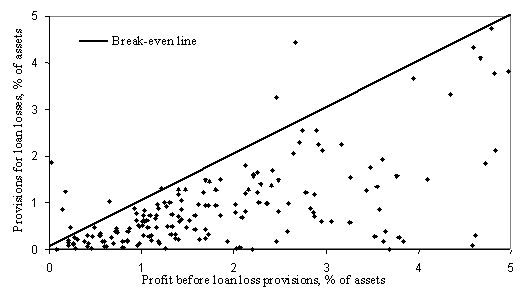
Note: Loss-making banks and banks with profit or more than 5% of assets in the half-year were not included
Source: Interfax CEA
The reverse was true for Sberbank, which posted a profit of 5.14 billion rubles in the first quarter and just 740 million rubles in the second quarter. Sberbank’s high first quarter profit was the result of high interest earnings on government securities. As a result, the total profit earned by solvent banks in the second quarter was 6.57 billion rubles, compared with 9.13 billion rubles in the first quarter.
A more thorough analysis shows that profit increased due to a drop in the write off of bad debts. In other words, at the will of bank management. Profit before reserves, which shows the foundation of bank profitability, was down 40% for the 100 biggest banks. Most banks by mid-2000 (with the only exception of Foreign Trade Bank) had written off bad debt left over from the 1998 financial crisis and now have balance sheets with a low share of past due loans.
It would be logical to suppose that the amount of reserves paid would depend on the quality of assets and be negatively related to bank profit before reserves (poorer quality of assets should at the same time lead to a drop in profit and an increase in reserves paid). But the figures do not support this.
In actuality the reverse dependence of profitability and the amount of reserves paid is made only for loss-making banks. For banks with better financials, the amount of reserves made is directly proportionate to profit before reserves are paid. Banks generally do not make the required amount of reserves, but pay only enough to avoid losses. The diagonal line in the figure separates the banks that made loan reserves and took losses (these banks are below the line) from banks that chose to limit the amount of reserves made to prevent losses. The figure clearly shows that the vast majority of banks opted for the latter strategy and this dependence is characterized by a very great significance even through an econometric test. It was because of this policy by most banks, generally supported by the Central Bank of Russia, that the write off of bad debt was stretched out over nearly two years.
It would be more correct to talk about profit received by banks as the profit given by the banks, rather than as an objective indicator of financial results. Most banks aimed for a figure that would be about 1% of assets for the half year to provide an “average market” level of profit, which actually shows the level of profitability determined by bank management.
Unfortunately, profits are not the only and most important distorted parameter. There are big banks with share of past due loans well below 1% of loans as shown on their books, but detailed analysis of different reporting forms suggests that the actual share is no less then 26% of loan portfolio. High capital is not enough guarantee for creditors, as it may be filled by bank's own loans.
Important problem in dealing with Russian banks is that they are fairly liquid and do not have serious problems servicing their debts. At the same time such liquidity has very transient nature and is not guaranteed be the same half year later. Even an insolvent banking system with high enough liquidity can conceal and accumulate problems as long as necessary.
Outsiders are often mislead by Russian reporting. Sometimes even Central bank takes steps to help Russian banks to hide their true condition. As a result reports may even comply to Central bank's standards but still be deceptive if judged by an outsider.
To our opinion some of basically unsound Russian banks with large amount of shareholder operations received recently upgrades of international rating. Most of the famous Russian bankrupts have been named "Best bank", received "Awards for excellence" and other flattering titles.
More forward looking analysis is needed that will see beyond current success that may be caused by uneconomic reasons. In fact some very successful banks may not be sound judged by their franchise value. Nowadays it's true more then ever.
Transparency of Russian banks is very low. Bank analysis in Russia needs to take into account a lot of local specifics and use much additional information on banks' and its peers standing.















